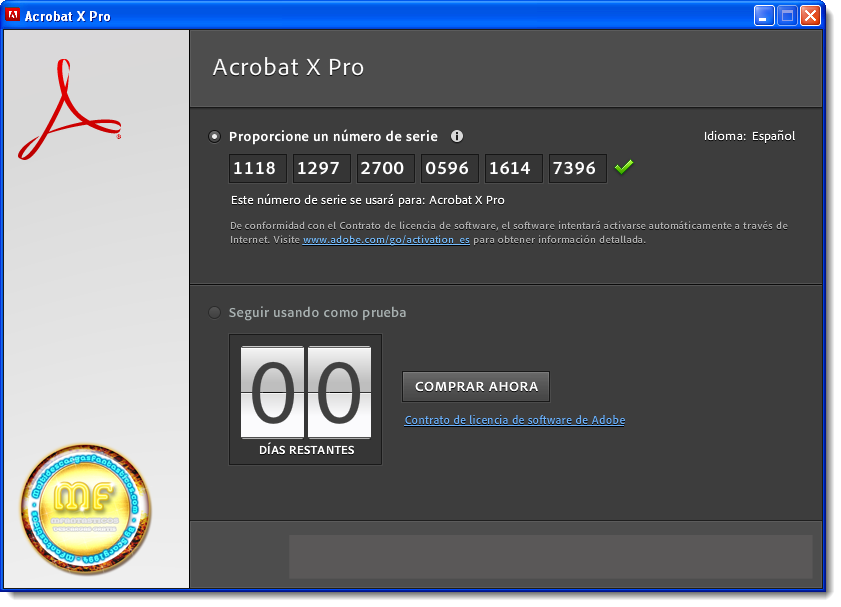

- #ADOBE ACROBAT PRO SERIAL NUMBER VERSION 17.011.30066 DOWNLOAD#
- #ADOBE ACROBAT PRO SERIAL NUMBER VERSION 17.011.30066 WINDOWS#
↑ Products and technical support periods, Adobe Systems. In May 2019, Adobe stopped providing the downloads entirely. Some users and websites had interpreted that Adobe was giving CS2 applications away for free, but Adobe clarified that these were only for registered users and required a valid existing serial number to access downloads. #ADOBE ACROBAT PRO SERIAL NUMBER VERSION 17.011.30066 DOWNLOAD#
Registered users who wished to continue using Acrobat 7 after that date could download a new installer from Adobe with a new serial number that could be activated without contacting a server.
#ADOBE ACROBAT PRO SERIAL NUMBER VERSION 17.011.30066 WINDOWS#
On December 15, 2012, activation servers for Adobe Creative Suite 2 applications were shut down, which also affected the Windows version of Acrobat 7. Version 7.1.4 was released on Octoand was the final update.Ĭore technical support ended on December 28, 2009.Version 7.1 was released on May 7, 2008.

 Version 7.0 was released on December 28, 2004. When the method proxy detects the bytes representing that placeholder object, it can replace those bytes with a stream of bytes representing an arbitrary deserialization payload\r\n\r\n# Fixing the Payload\r\nWhen I first spotted the file \u201clibs/rome-cf. A great example of this is that a remote method which expects a parameter of type cannot be supplied with an arbitrary object parameter, however if we modify the outbound remote method invocation at the network level using a proxy then we can supply an arbitrary object and the server will deserialize it.\r\n\r\nUsing an RMI method proxy, we can issue a call to a remote method in the normal way but with a placeholder parameter instead of a payload object. It works as follows:\r\n\r\n* Start an RMI registry proxy that forwards connections on to the target RMI registry\r\n* Call LocateRegistry.getRegistry() with the host and port of the RMI registry proxy, not the host and port of the RMI registry service\r\n* Call Registry.lookup() to retrieve a remote object reference via the RMI registry proxy (which forwards the request to the real RMI registry service)\r\n* When the RMI registry proxy detects a remote object reference being returned:\r\n\t* It starts an RMI method proxy to forward connections on to the real RMI object service\r\n\t* It modifies the remote object reference to point at the new RMI method proxy rather than the real RMI object service\r\n* When a method is invoked on the remote object reference, the connections now go through the RMI method proxy\r\n\r\nWith remote method invocations going through a proxy, I have complete control over the protocol and I can manipulate things that the Java Virtual Machine would otherwise prevent me from manipulating. To achieve this, I built a proxy framework that allowed me to man-in-the-middle both connections. The problem was that there\u2019s no way to natively pump arbitrary bytes down an RMI connection in such a way that the receiving server would deserialize those bytes. command strings and corresponding length fields). The way I achieved this was to have hard-coded static payloads and generate dynamic sections on the fly (e.g. \r\n```\r\n# Manning the Middle\r\nWhile I was building BaRMIe, I wanted to include as many exploit payloads (POP gadget chains) as possible without having to battle with dependencies and multiple versions of dependencies.
Version 7.0 was released on December 28, 2004. When the method proxy detects the bytes representing that placeholder object, it can replace those bytes with a stream of bytes representing an arbitrary deserialization payload\r\n\r\n# Fixing the Payload\r\nWhen I first spotted the file \u201clibs/rome-cf. A great example of this is that a remote method which expects a parameter of type cannot be supplied with an arbitrary object parameter, however if we modify the outbound remote method invocation at the network level using a proxy then we can supply an arbitrary object and the server will deserialize it.\r\n\r\nUsing an RMI method proxy, we can issue a call to a remote method in the normal way but with a placeholder parameter instead of a payload object. It works as follows:\r\n\r\n* Start an RMI registry proxy that forwards connections on to the target RMI registry\r\n* Call LocateRegistry.getRegistry() with the host and port of the RMI registry proxy, not the host and port of the RMI registry service\r\n* Call Registry.lookup() to retrieve a remote object reference via the RMI registry proxy (which forwards the request to the real RMI registry service)\r\n* When the RMI registry proxy detects a remote object reference being returned:\r\n\t* It starts an RMI method proxy to forward connections on to the real RMI object service\r\n\t* It modifies the remote object reference to point at the new RMI method proxy rather than the real RMI object service\r\n* When a method is invoked on the remote object reference, the connections now go through the RMI method proxy\r\n\r\nWith remote method invocations going through a proxy, I have complete control over the protocol and I can manipulate things that the Java Virtual Machine would otherwise prevent me from manipulating. To achieve this, I built a proxy framework that allowed me to man-in-the-middle both connections. The problem was that there\u2019s no way to natively pump arbitrary bytes down an RMI connection in such a way that the receiving server would deserialize those bytes. command strings and corresponding length fields). The way I achieved this was to have hard-coded static payloads and generate dynamic sections on the fly (e.g. \r\n```\r\n# Manning the Middle\r\nWhile I was building BaRMIe, I wanted to include as many exploit payloads (POP gadget chains) as possible without having to battle with dependencies and multiple versions of dependencies.







 0 kommentar(er)
0 kommentar(er)
